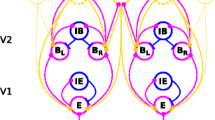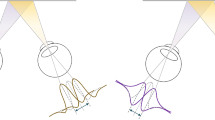Abstract
Illusory contours occurring in the various perceptual phenomena are essentially accompanied with illusory surfaces. Accordingly, we propose a novel approach for the perception of illusory surface arising from illusory contours. The proposed method uses a hierarchical neural network model. It is likely done in the visual cortex domain in a cascade manner, and uses the response properties of neuron cells found in the visual pathways. The stimuli for forming the illusory contours are induced by modelling the end-stopped cell, and the induced stimuli for the surface perception is then formed from the extracted illusory contours. Finally, the surface perception is completed by restoring surface successively from the induced contour stimuli. The proposed model was demonstrated on a variety of illusory contour figures, and experimental results showed that the perception of illusory surface is a very successful.
This research was supported by the Yeungnam University research grants in 2004.
Preview
Unable to display preview. Download preview PDF.
Similar content being viewed by others
References
Kumaran, K., Geiger, D., Gurvits, L.: Illusory surface perception and visual organization. Computation in Neural Systems 7, 33–60 (1996)
Hubel, D.: Eye, Brain, and Vision (1995), http://neuro.med.harvard.edu
Marr, D.: Vision: A Computational Investigation into the Human Representation and Processing of Visual Information. W. H. Freedom&Company, New York (1982)
Marr, D., Hildreth, E.: A theory of edge detection. In: Proc. R. Soc. Lond., vol. B(207), pp. 187–217 (1980)
Hubel, D.H., Wiesel, T.N.: Receptive fields binocular interaction and functional architecture in the cat’s visual cortex. J. Physiology, 106–154 (1962)
von der Heydt, R., Peterhans, E.: Mechanisms of contour perception in monkey visual cortex. I. Lines of pattern discontinuity. J. of Neuroscience 9, 1731–1748 (1989)
Hukushima, K., Miyake, S., Ito, T.: Neocognitron: A neural network model for a mechanism of visual pattern recognition. IEEE Trans. Syst., Man, Cybern. SMC-13, 826–832 (1983)
Author information
Authors and Affiliations
Editor information
Editors and Affiliations
Rights and permissions
Copyright information
© 2005 Springer-Verlag Berlin Heidelberg
About this paper
Cite this paper
Lee, W., Kim, W. (2005). Illusory Surface Perception Using a Hierarchical Neural Network Model of the Visual Pathways. In: Gagalowicz, A., Philips, W. (eds) Computer Analysis of Images and Patterns. CAIP 2005. Lecture Notes in Computer Science, vol 3691. Springer, Berlin, Heidelberg. https://doi.org/10.1007/11556121_87
Download citation
DOI: https://doi.org/10.1007/11556121_87
Publisher Name: Springer, Berlin, Heidelberg
Print ISBN: 978-3-540-28969-2
Online ISBN: 978-3-540-32011-1
eBook Packages: Computer ScienceComputer Science (R0)




